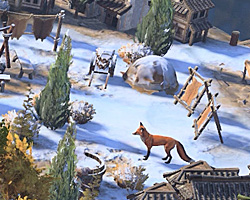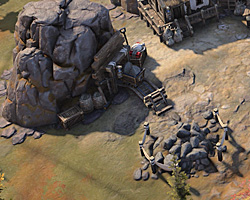*This page last updated: 25 January, 2025 10:48 PST. (Log of recent changes)
Terrain
Terrain appears similar to Civ 6, though more detailed and stylistically a bit more like Civ 5. However, it appears that there is now a restriction on map types; exploration is restricted in the first Age, and there must always be a second continent to explore in the second Age.
Homelands and Distant Lands
Ed Beach: "One of our problems was that exploration lasted about 50 or 70 turns, something like that, and occasionally you would get it later, when you cross the ocean, but with some of our maps the whole map was just one big continent and you didn’t even have the other side of the world to explore. Now we are setting up the game so there’s always a second half of the world. No matter what your first land mass looks like, there’s always an ocean separating you from the other half. And so when you go into the age of exploration… it’d be horrible for us to name it the age of exploration and the exploration’s all done, right?"
- There are waterfalls and complex terrain with changes in elevation.
- The maximum discoverable size of the map is limited in each Age and expands at the start of the next Age.
- There are cliffs that function similar to the sea cliffs in Civ6, but they can also occur inland. Units cannot cross a cliff hexface, but they can still shoot across it.
- Difficult terrain (Wet, Vegetated, Rough or River tiles) now end the movement of units entering them, regardless of movement points. Some units (such as Scouts) have special abilities that allow them to ignore certain difficult terrain.
- I assume that Mountainous terrain is impassible.
- Open Ocean counts as Difficult Terrain and causes damage each turn to units before the Astronomy tech is researched.
Rivers
Rivers now run through the center of hexes instead of along the edges. There are Minor Rivers, which are familiar from previous games, and Navigable Rivers, which can be occupied by naval units. Fishing Boats may also be built on Navigable Rivers.
- Fresh water now provides Happiness bonuses. Fresh water exists on minor river tiles, and adjacent to navigable river tiles.
- You can't build districts directly on Navigable River tiles, as they count as water tiles. But you can build some improvements (Fishing boats).
- There is a Floodplains feature on some river tiles, which are presumably susceptible to a flooding disaster.
- A Minor River is disadvantageous terrain and imposed a -5 Combat Strength penalty to a unit defending on that tile.




Base Terrain Types
- Desert
- Oasis (Wet)
- Sagebrush Steppe (Vegetated)
- Grassland
- Marsh (Wet)
- Forest (Vegetated)
- Tundra
- Taiga (Vegetated)
- Bog (Wet)
- Plains
- Watering Hole (Wet)
- Savannah Woodlands (Vegetated)
- Tropical
- Rainforest (Vegetated)
- Mangrove Swamp (Wet)
- Marine
- Lake
- Ocean
- Coast
Modifiers
- Flat
- Rough
- Mountainous
- Coastal
- Navigable River
Features
- Vegetated
- Wet
- Minor River
- Navigable River
- Reef (Aquatic)
- Medium Snow
- (Ice)
Vegetated: Flat Tropical Rainforest, Forested Grassland and Flat Plains Savannah Woodlands
Vegetation now vary depending on the terrain type. Rainforest now has mist rising from it.




Wet: Flat Grassland Marsh and Flat Plains Watering Hole




Mountainous Desert, Grassland, Tropical, and Tundra





Flat Tundra Taiga Snow and Rough Tundra Medium Snow


Flat Grassland and Flat Plains


Flat & Rough Desert, Flat Desert Sagebrush Steppe, Flat Desert Oasis, and Navigable River Desert Floodplain




Marine: Coastal, Ocean, and (Ice)



Resources
It appears that there is no longer a distinction between Luxury, Strategic and
other resources. Some resources do provide Happiness as a yield, however.
"Each Age contains a set of obtainable Resources on the map that were available
during that time period. Some Resources span multiple Ages, while others are
exclusive to an individual Age."
- Empire Resources: Bonuses that assist you anywhere on the map. Many of these are the old strategic resources from previous Civ games, like Iron.
- City Resources: Bonuses that help you specialize the yields and abilities of a specific City (not a Town!). City Resources enable you to create Cities that are especially good at Science, Culture, or Gold output. Can only be assigned to Cities, not Towns.
- Bonus Resources: Flat yield buffs that you can move to any Settlement, including Towns. These are very useful in boosting Settlements that are getting unhappy, or for accelerating growth.
- Treasure Resources are found only in Distant Lands in the Exploration Age and spawn Treasure Fleets when improved.
- Factory Resources in the Modern Age can be slotted into special Factory resource slots to obtain additional empire-wide bonuses.
It looks like resources that persist across Ages may have different bonuses in each Age, so the list below is hit or miss at the moment.
Known resources:
- Camels: Increases number of Resources that can be assigned to a City by 2
- Citrus: Factory Resource. +5% Production towards training Naval Units.
- Cocoa: Creates Treasure Fleets when connected to a coastal Settlement
- Coffee: Factory Resource. +5% Production towards constructing Buildings and Wonders.
- Cotton: +2 Food, +2 Production
- Dates: +2 Food, +2 Happiness
- Dyes: _5 Happiness
- Fish: Factory Resource. +5 Settlement Growth Rate
- Furs: +6 Happiness in a City with a Rail Station, +3 Happiness to any other City.
- Gold: +20% Gold towards purchasing Buidlings
- Gypsum: +2 Production to Capital, +4 Production to any other City
- Horses
- Iron: Infantry Units gain +1 Strength
- Ivory: +10% Production towards Wonders placed in Tropical, Plains, and Desert Terrain
- Jade: +15% Gold
- Kaolin: Factory Resource. +3% Culture.
- Marble: +10% Production towards Wonders placed in Grassland, Tundra and Marine tiles
- Oil: Heavy Naval and Cavalry Units gain +1 Combat Strength, and an additional +1 against Infantry Units.
- Pearls: +3 Happiness in Homeland Cities; +6 Happiness in Distant Land Cities
- Tobacco: +6 Production in a City with a Rail Station. +3 Production in any other City.
- Quinine: Factory Resource. Units heal +1 HP.
- Truffles: +20% Production towards training Units
- Salt: +20% Production towards training Units
- Niter: Ranged and Siege Units gain +1 Combat Strength, and an additional +1 against Cavalry units
- Silk: +10% Culture
- Rubber: +1 Combat Strength to ?
- Silver: +20% Gold towards purchasing Units
- Stone
- Sugar: Creates Treasure Fleets when connected to a coastal Settlement
- Tea
- Whales: +5 Production
- Wine: +2 Happiness in the Capital and +10% Culture when in a Celebration
- Wool: +2 Production, +2 Happiness




























Discoverables
Various special items around the map, such as "Goody Huts" and Shipwrecks can be collected for bonuses (often a choice of bonuses). These appear to be indicated by a blue sparkly effect. Examples include shipwrecks, Wreckage and Ruins.








Other Terrain Features
(Barbarian Camp)
One of the Antiquity Age Crises is for barbarian camps to spawn around the map.

Natural Wonders
These appear to operate the same as in Civ 6.
Great Barrier Reef

Gullfoss
+1 Culture and Production to adjacent Rural tiles.

Grand Canyon
+2 Science on Flat Terrain in this Settlement.


Hoerikwaggo


Iguazú Falls
+2 Production on adjacent Quarters. Grants Fresh Water.


Kilimanjaro

Redwood Forest
Each of the three tiles gives +2 Food and +2 Production locally and +2 Happiness empire-wide. +1 Science and +1 Culture to all vegetated tiles in the owning Settlement.


Thera
+6 Culture and +3 Happiness on each tile.


Torres del Paine
Valley of Flowers

Uluru

Zhangjiajie



